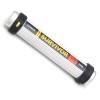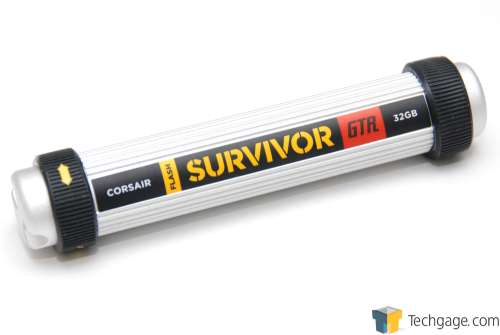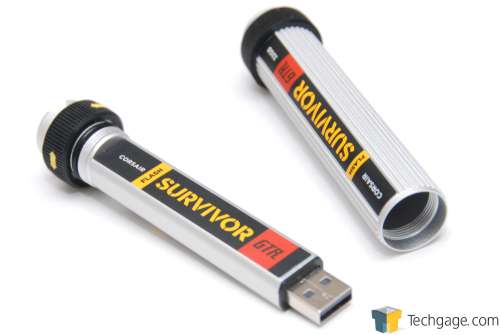- Qualcomm Launches Snapdragon 4 Gen 2 Mobile Platform
- AMD Launches Ryzen PRO 7000 Series Mobile & Desktop Platform
- Intel Launches Sleek Single-Slot Arc Pro A60 Workstation Graphics Card
- NVIDIA Announces Latest Ada Lovelace Additions: GeForce RTX 4060 Ti & RTX 4060
- Maxon Redshift With AMD Radeon GPU Rendering Support Now Available
Corsair Survivor GTR 32GB Flash Drive

As the market begins to fill up with USB 3.0 storage devices, it might seem like we’re nearing a USB 2.0 end. But that will still take some time, and as Corsair helps prove with its Survivor GTR, there’s still life left in the now-aging standard. Not only is this drive ultra-fast, but it’s also ultra-durable – giving you the best of both worlds.
Page 4 – Final Thoughts
Believe it or not, the USB 2.0 standard turned 10-years-old this past April, so Corsair’s Survivor GTR did well to celebrate its anniversary. As we’ve seen throughout all of our testing, this drive, along with the Voyager GTR which shares the exact same specs and internal design, are blazing-fast, almost pushing the USB 2.0 available bandwidth to its tipping-point.
For utmost performance, it’s hard to go wrong with with either of the GTR models. In our real-world testing, we copied a 4GB file to the drive at 24 MB/s, and copied a 4GB folder at a respectable 6.6 MB/s. The latter seems unimpressive when the drive is rated for 28 MB/s, but like most storage devices, the drive’s stamina degrades quite a bit over the duration of the transfer. This effect is especially common on mechanical storage, but not so much with SSD’s.
Interestingly enough, the IOPS performance on the GTR wasn’t as impressive as what we saw on Kingston’s value-derived DataTraveler 101 G2. This surprised me quite a bit simply because the GTR’s quad-channel design should give us improved IOPS performance. My theory is that in order to save money, Corsair chose to use lower-quality memory ICs in its GTR drives, but because they are in quad-channel RAID, the raw performance is still exceptional.
For most users, the IOPS isn’t going to matter, but as mentioned before, higher IOPS would improve the performance of an installed OS on the drive, since OSes tend to constantly read and write to its primary storage device.
As it is though, compared to Kingston’s drive, Corsair’s GTR performed quite well in our real-world transfer tests, especially when dealing with a single file. While Kingston’s DT 101 G2 took about 37 minutes to transfer a solid 16GB file, the GTR managed the same task in 10m 10s. It’s when large folders are brought into play that the two began to even out, thanks to the long-term performance degradation.
In our real-world tests, though, the benefit of using a true USB 3.0 drive in 2.0 mode became clear. Even though the overall throughput is going to be the same for all USB 2.0 devices capable of ultra-high speeds, the higher-quality memory IC’s in Super Talent’s SuperCrypt drive helped prolong high-end performance for as long as possible. Again, while Corsair’s GTR transferred that 16GB file in 10m 10s, Super Talent’s 3.0 drive in 2.0 mode transferred it in just 6m 46s.
Where companies like Corsair are still ahead in the 2.0 game is thanks to the fact that 3.0 devices are far more expensive. The GTR as mentioned earlier retails for around $100, while Super Talent’s SuperCrypt of the same density retails for $170. So while there stands to be some major performance gains thanks to the higher-end chips in 3.0 devices, the cost-of-entry is still far higher.
Of course, if you’re looking to purchase a Survivor drive, the huge performance might just be an added bonus given that the durability-factor is a huge selling-point on its own. The drive’s design as a whole seems rather straight-forward, but the fact of the matter is, it works. I’d be willing to bet that this drive would even survive a fall from a plane, because being as light as it is overall (~140 grams), smashing it hard with a hammer would no doubt be more forceful than a drop to the ground. And it does survive a good smash of a hammer.
For those looking for the ultimate durable drive that doesn’t lack performance, the Survivor GTR is a great choice. And of course, it’s the only choice if you want a Corsair-branded dog-tag. For those who want the same performance but in a smaller (and subsequently much less durable) frame, the Voyager GTR which retails for around the same price is for you.

Corsair’s Survivor GTR Flash Drive
Discuss this article in our forums!
Have a comment you wish to make on this article? Recommendations? Criticism? Feel free to head over to our related thread and put your words to our virtual paper! There is no requirement to register in order to respond to these threads, but it sure doesn’t hurt!
Support our efforts! With ad revenue at an all-time low for written websites, we're relying more than ever on reader support to help us continue putting so much effort into this type of content. You can support us by becoming a Patron, or by using our Amazon shopping affiliate links listed through our articles. Thanks for your support!







